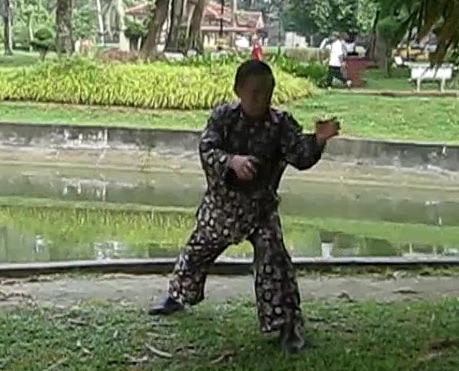HISTORY AND PHILOSOPHY OF
SHAOLIN 72 CHIN-NA TECHNIQUES

"Lead Horse Back to Stable" of Shaolin 72 Chin-Na Techniques
The Shaolin 72 Chin-Na (Qin-Na) Techniques are top secrets, but to preserve this high-level art for posterity, I taught a Special Chin-Na Course in Sabah in 2008, and have decided to reveal the techniques to the public in both videos and pictures.
Because of the long history of Shaolin Kungfu, there are different versions of the Shaolin 72 Chin-Na Techniques, but the main techniques are similar. The version here was composed by me based on my many years of practicing Shaolin Kungfu as well as reference to kungfu classics.
Chin-na, spelt as "qin-na" in Romanized Chinese, was not popularly used in early Shaolin Kungfu, which was characterized by Lohan Fist, with emphasis on striking and some kicking. Shaolin chin-na techniques were not explained in the famous collection of Shaolin classics written in the year 961 during the Song Dynasty (10th to 13th centuries).
Shaolin chin-na became more frequently used after the "Shaolin Five-Animal Set" replaced "Lohan Fist" as the Shaolin kungfu prototype. With the development of Tiger-Claw, Eagle-Claw and Dragon-Claw, chin-na techniques became established, probaby during the Ming Dynasty (14th to 17th centuries). But chin-na technqies were used only by masters; ordinary practitioners mainly used strikes.
This was because a master needed four movements to execute a chin-na technique effectively, whereas a practitioner needed only one movement to execute a successful strike. A successful kick required two movements, and a successful felling attack required three.
When you make a strike, like Black Tiger Steals Heart, you need just one movement. When you make a kick, like Happy Bird Hops up Branch, you need two movements -- you need to adjust yourself and then kick. A colloquial kungfu saying mentions that "when your opponent moves his shoulders, you know a kick is coming".
You need three movements to execute a felling attack, like Uprooting Tree with Roots. You need to cover your opponent so that he cannot strike you (a precaution many modern martial artists, like Judo exponents, neglect), off-balance your opponent (not wrestle with him), then apply your felling technique.
To apply a chin-na technique, like Lead Horse Back to Stable, you need four movements. You need to maneuver yourself into a suitable position (a move that may not be necessary in other categories of attack), cover your opponent so that he cannot strike you, apply "chin" which is holding, and then apply "na" which is gripping. A chin-na master can accomplish these four movements so effectively before his opponent can make one move to neutralize the chin-na attack. It is not just speed that is involved. A chin-na master uses tactics and strategies.
Not many people know that chin-na actually consists of two techniques, namely holding and gripping. You need to hold an opponent in place before gripping him effectively. The gripping is special. An opponent is gripped in such a way that he loses his fighting ability. Hence, chin-na is combat ending. It is also compassionate, as the victims can retrieve their normal ability after the chin-na injury has been healed.
There are three main ways how chin-na ends combat:
- fun ken (in Cantonese pronunciation), which means separating tendons.
- chor jit, which means wronging joints.
- na yuit, which means gripping energy points.
The most commonly used method is "na yuit", or gripping energy points. When an opponent's energy flow is interrupted, he could not continue fighting. Later when he sought the help of a master or Chinese doctor to restore his energy flow, he returns to normalcy.
Chin-na is one of the three "ultimate arts" of Shaolin, the other two being "dim mark" and "noi kung", or dotting energy points and internal arts. Chin-na was taught in a special Chin-Na Course in Sabah in 2008, and dim-mark in a special Dragon Strength Course in Penang in 2014. It is incredible that all Shaolin Wahnam students, not just those who practice kungfu, learn "noi kung" or internal arts as soon as they learn in our school!
The Shaolin 72 Chin-Na Techniques practiced in our school are linked into a set here, with its picture series here. To enable students to understand the combat application of the 72 Chin-Na Techniques, I composed 72 Chin-Na Combat Sequences here. To enable students to better remember the 72 combat sequences, they are linked into 72 Chin-Na Combat Sequence Sets which can be accessed here.
Wong Kiew Kit
21st December 2015
LINKS
